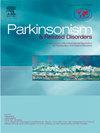Acoustic prosodic parameters associated with Parkinson's disease cognitive impairment
IF 3.1
3区 医学
Q2 CLINICAL NEUROLOGY
引用次数: 0
Abstract
Background
Acoustic prosodic analysis is a novel approach that can be used to identify patients with mild cognitive impairment (MCI) and dementia in Alzheimer's disease (AD). We hypothesize that acoustic analysis can also differentiate cognitive impairment in Parkinson's disease (PD).
Methods
We investigated acoustic parameters in 90 subjects including 30 PD with normal cognition (PD-NC), 30 PD with mild cognitive impairment (PD-MCI) and 30 PD with dementia (PDD). The reading task “Supermarket Passage” and the picture description task “Cookie Theft” were used. Feature selection and modelling were then performed to systematically evaluate the importance and clinical implications of the acoustic parameters in identifying PD with cognitive impairment.
Results
Analysis of covariance (ANCOVA) and mediation analysis revealed that acoustic parameters were independently associated with cognitive impairment including PDD and PD-MCI. These Acoustic parameters enabled the detection of PD with cognitive impairment with an area under the receiver operating characteristic curve (AUC) of 0.826. Compared with PD-NC, speech rate, pre-verb pause (≥1s), between-utterance pause (≥2s) in the “Cookie Theft” task were the two key cognitive impairment detection factors, which were frequently identified by LASSO model in both PDD and PD-MCI. F0SD of interrogative sentence was often selected in PDD. In feature selection, AUC was 0.944 in discriminating PDD from PD-NC and AUC was 0.753 in discriminating PD-MCI from PD-NC.
Conclusion
We demonstrated that acoustic parameters are useful in differentiating PD patients with cognitive impairment from patients with normal cognition after adjusting variables such as age, which was also a significant contributor to cognitive decline. Acoustic parameters may be valuable for automated screening the risk of cognitive decline in PD patients. It deserves further investigation.
求助全文
约1分钟内获得全文
求助全文
来源期刊

Parkinsonism & related disorders
医学-临床神经学
CiteScore
6.20
自引率
4.90%
发文量
292
审稿时长
39 days
期刊介绍:
Parkinsonism & Related Disorders publishes the results of basic and clinical research contributing to the understanding, diagnosis and treatment of all neurodegenerative syndromes in which Parkinsonism, Essential Tremor or related movement disorders may be a feature. Regular features will include: Review Articles, Point of View articles, Full-length Articles, Short Communications, Case Reports and Letter to the Editor.
 求助内容:
求助内容: 应助结果提醒方式:
应助结果提醒方式:


